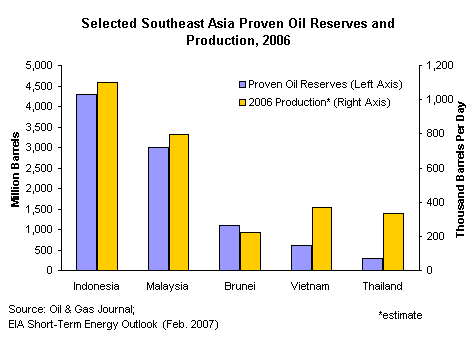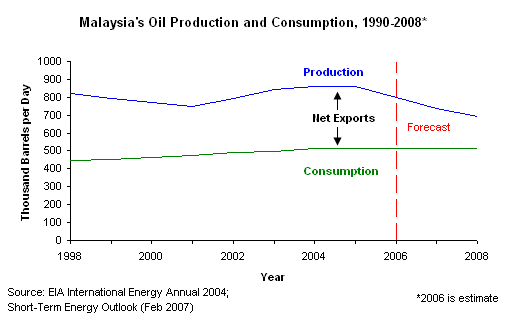A Visit To Malaysia
Posted by Big Gav in malaysia, palm oil, petronas, rubber
I spent a week in Malaysia back in June, loafing about in the sun on the island of Langkawi. While I mostly tried to ignore the news flow, I did read the local paper each day and there seemed to be plenty of energy related stories on the boil. These ranged from prominent exposure of the global "energy and food crises" to more locally focused issues, which I'll take a look at in this post.
Tourism
Tourism is Malaysia's third largest foreign exchange earner after manufactured goods and palm oil, so rising fuel prices are likely to crimp the local economy (although palm oil exports would seem likely to offset the impact on the other 2 sectors).
This was borne out anecdotally during my visit, as the resort driver who took us to the airport at the end of our visit noted that off season was much quieter than normal, with a occupancy rate of around 30% compared to the usual 50%, which he blamed on the rising price of oil. This doesn't seem to be reflected in overall visitor numbers so far though, so perhaps it is just the higher-end resorts that are being impacted so far.

As taxi drivers go he seemed remarkably well-informed about energy issues, following this opening gambit with a long line of questions about my opinion of the future of oil prices, the pros and cons of using LPG / CNG fuelled cars vs electric cars, what energy sources Australia used to generate electricity, how much fossil fuel we export and the impact of the Australian drought on rice prices.
Oil Production
Malaysian oil reserves, believed to be around 4 billion barrels, are estimated to last less than 20 years at the current rate of production. The country is now widely assumed to now be past peak. The country is still a net oil exporter, however there has been speculation that this may end as soon as 2011, becoming yet another example of the "export land" phenomenon.
The EIA forecasts that Malaysia’s oil production will fall to 693,000 bbl/d in 2008, a 13 percent decrease from 2006 levels. Most new oil fields are located offshore. Recent finds have largely been off Sabah state on the island of Borneo, with 26 deepwater fields discovered since Murphy Oil discovered the Kikeh field in 2002. Seven of these fields are slated for development over 2008 to 2012. For the time being, these new fields are compensating for the depletion of existing fields, with production rebounding somewhat recently.


Oil represents around 10% of Malaysia's export income.
Peak oil wasn't mentioned in the local press during my visit, though Shell was doing a roadshow of their latest scenario planning output - Blueprints or the Scramble.
Petronas
Petronas is Malaysia's national oil company - wholly owned by the government and reporting directly to the Prime Minster (not Parliament). It ranks in the top 100 corporations globally, is the 8th most profitable in the world and the most profitable in Asia.
Petronas' oil income has enabled the Malaysian government to fund all sorts of grand experiments, from the famous Petronas Towers in Kuala Lumpur to paying for Malaysian astronauts to go into space as passengers on Russian expeditions - this wasteful expenditure has come in for criticism though from people concerned that this dwindling income stream could be put to better uses and is often being wasted.
This criticism has increased in recent months, as Petronas' soaring income has been matched by cuts to government fuel subsidies, resulting in a 40% jump in the price of fuel (though it is still cheap enough for smugglers to try to arbitrage the price difference between Malaysia and Thailand it seems, judging by the local press) and sparking protests across the country.
The government has responded to the unrest by offering a special dividend to "ease the people's burden".
The company is trying to adapt to declining discoveries in its home market by expanding abroad in a variety of locations, including Myanmar, Russia, Mauritania, South Africa, Sudan and Iran.

Palm Oil And Food Prices
Malaysia is one of the world's largest producers of palm oil - an important feedstock for biodiesel production.

The price of palm oil has soared in recent years, from around 1200 ringgit per ton to almost 4000 ringgit per ton - only recently sinking back to the 3000 ringgit per ton mark.
Oil palm cultivation uses 67 percent of Malaysia's agricultural land, and around 500,000 people work in the industry. The country expects palm oil production will hit 20 million tonnes by 2020.
There has been concern expressed locally as well as internationally about the impact on food prices of using palm oil for fuel instead of for cooking. There are also concerns that continued expansion of oil palm cultivation will mean extinction for the orang utan.
During the mild panic that erupted over rising rice prices in the first half of the year, the Malaysian government threatened to start bartering palm oil for rice, bypassing international commodity markets entirely.

Gas Prices And Rubber Gloves
Rubber prices have soared in recent years, with rubber plantations now expanding rapidly as a result, sometimes at the expense of palm oil plantations.
My energy enthusiast taxi driver noted that this has been positive for rubber farmers like his father, who are frequently small holders and traditionally had a difficult and lowly paid job. Apparently over the past decade incomes for these farmers have increased 10 fold, from something like $30 per month to $300 per month (no - you won't get rich becoming a rubber farmer).

Gas prices have also risen sharply, amplified by cuts to government subsidies.
The combination of these two factors has meant trouble for rubber glove manufacturers, who use both rubber and gas in glove production. One Malaysian business, Kossan, is the world's third largest glove manufacturer - producing 12 billion items per year - with gas comprising the bulk of production costs. Another Malaysian producer, Top Gloves, is the world number one, producing 30 billion gloves per year.
Glove manufacturers aren't the only ones impacted, with the price of tyres and rubber boots also on the rise.
Somewhat surprisingly, given Malaysia's relatively plentiful gas supplies, peninsula Malaysia has insufficient supply to meet demand, with 23% of gas used imported.
This has lead to the bizarre situation of the country building coal fired power plants to meet its energy needs, baulking at building a gas pipeline and instead relying on Indonesian coal exports. On a slightly brighter note, the coal plants are replacing a lot of existing diesel fuelled generators, and the government is promoting the upgrade of old gas turbines to new efficient models.





